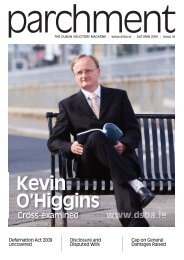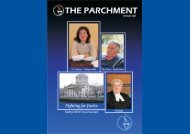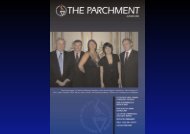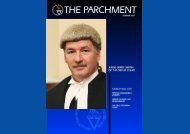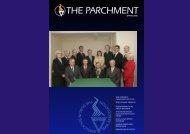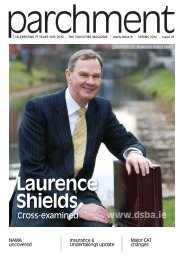A TRIBUTE TO OUTGOING PAST PRESIDENT BRIAN GALLAGHER
to download ParchSpringWeb07.pdf - the Dublin Solicitors Bar ...
to download ParchSpringWeb07.pdf - the Dublin Solicitors Bar ...
- No tags were found...
You also want an ePaper? Increase the reach of your titles
YUMPU automatically turns print PDFs into web optimized ePapers that Google loves.
LITIGATION - BACK<br />
<strong>TO</strong> BASICS<br />
Basic Guide to Personal<br />
Injuries Assessment<br />
Board/Personal Injury<br />
Procedure<br />
Most members may find this simple guide<br />
to procedure for personal injuries as<br />
surplus to requirements or too basic to<br />
consider, however, there is certainly no<br />
harm in revisiting the fundamentals and<br />
members who do not practice exclusively<br />
in personal injury cases will hopefully get<br />
some benefit.<br />
Remind me? What cases are<br />
involved?<br />
Section 3 of the PIAB Act, 2003 sets out<br />
that the PIAB procedure must be adopted<br />
in a civil action for<br />
Employee against his/her employer for<br />
negligence or breach of duty arising in the<br />
course of employment with that employer.<br />
Action by a person against another arising<br />
out of that others ownership, driving or<br />
use of a mechanically propelled vehicle.<br />
Action by a person against another arising<br />
out of that others use or occupation of<br />
land or any structure or building.<br />
Not falling within any of the proceeding<br />
paragraphs other than cases of medical or<br />
surgical negligence.<br />
Do I need a section 68 letter for<br />
these cases?<br />
Yes a Section 68 letter must be issued to<br />
the client setting out where possible the<br />
costs that will be incurred for you to<br />
conduct the case for the client through the<br />
PIAB. With recent developments and<br />
particularly the costs report and indeed the<br />
new overall focus on legal fees its seems<br />
to be expected that solicitors would quote<br />
an hourly rate as opposed to basing a fee<br />
on the possible quantum size of the case.<br />
It is preferable that the client would sign<br />
the section 68 letter which should be<br />
retained on the file.<br />
How do we approach the Personal<br />
Injuries Assessment Board?<br />
Form A1 must be completed by the client<br />
at instruction stage if possible and also in<br />
addition the solicitor should get a letter of<br />
authority from the client addressed to<br />
PIAB explaining that PIAB is from that<br />
point forward to deal with that applicant’s<br />
solicitor and not directly with the<br />
applicant. The Law Society have produced<br />
a precedent which suffices for this task.<br />
Do I contact PIAB or the<br />
Defendant/Respondent?<br />
An initial letter should be sent to the<br />
Defendant/Respondent advising them of<br />
the client’s cause of action and offering<br />
them the opportunity to compensate at that<br />
stage. This should be done within two<br />
months of the date of the incident<br />
concerned or as soon as practicably<br />
possible thereafter. There are new<br />
implications in relation to costs where this<br />
tight time frame is not adopted. As before<br />
where there is potentially more than one<br />
Defendant/Respondent the “O’Byrne”<br />
letter must issue to the relevant parties.<br />
What happens next?<br />
Depending on the response received (if<br />
any) you should then be in a position to<br />
formally lodge your application with<br />
PIAB. In order to do so you require the<br />
following.<br />
Completed application form.<br />
Original letter/authority from the claimant<br />
to PIAB.<br />
Medical report from the client’s doctor.<br />
Copies of any correspondence between<br />
the client and the Respondent or the<br />
client’s solicitor and the<br />
Respondent/Insurance Company.<br />
Any vouchers, receipts or documentary<br />
proof in respect of any financial loss<br />
suffered by the client/loss of earnings.<br />
Cheque for 50.00 payable to PIAB.<br />
Any other documentation relevant to the<br />
claim.<br />
How long does it take?<br />
The solicitor should immediately seek to<br />
get acknowledgement from PIAB that the<br />
application is deemed received and<br />
complete under section 50 of the PIAB<br />
Act, 2003. Remember that the Statute of<br />
Limitations continues to run until this<br />
formal notification is received. Once<br />
received the Statute of Limitations is on<br />
hold until the claim has been dealt with<br />
and until six months thereafter.<br />
Is that all it takes?<br />
There may be further or additional<br />
information required by PIAB. They may<br />
refer your client to a medical attendant.<br />
PIAB will effectively engage the<br />
Respondent with a view to settling the<br />
claim provided they accept full liability. If<br />
the Respondent decides to have the claim<br />
assessed then your client should quantify<br />
in so far as possible the loss incurred and<br />
also make reference to the Book of<br />
Quantum before accepting or rejecting any<br />
assessment amount.<br />
What happens if the Respondent declines<br />
to have the claim assessed?<br />
PIAB will issue an authorisation to<br />
proceed to court. Pleadings should be<br />
drafted and issued through the appropriate<br />
court office and the authorisation from<br />
PIAB will be necessary to do this.<br />
Teething problems are still being<br />
experienced when solicitors attempt to<br />
issue these proceedings and the DSBA is<br />
attempting to iron out these administrative<br />
problems with Court Services but the<br />
intention is that a Personal Injuries<br />
Summons will be issued and served on the<br />
Defendant.<br />
What happens if the Respondent accepts<br />
liability but the client refuses to accept the<br />
amount of the assessment?<br />
It is important to note that under section<br />
51(1) of the PIAB Act the PIAB<br />
procedure is effectively “without<br />
prejudice” and no admission of liability<br />
within the PIAB procedure will be<br />
permitted in the substantive proceedings<br />
themselves. In these circumstances it<br />
could be viewed that the entire procedure<br />
is a waste of time and of no assistance in<br />
deciding the case either way. However,<br />
the commencement of court proceedings<br />
opens the matter as if for the first time, or<br />
“ab initio”.<br />
Aaron McKenna, Chair of the Litigation<br />
Committee<br />
Note: the Lawsociety have prepared<br />
precedents for practice for PIAB which<br />
can be accessed in the members area of<br />
the Lawsociety website<br />
www.lawsociety.ie<br />
Warning – 30 TH March 2007<br />
Statute of Limitations<br />
Deadline Approaching–<br />
Check your litigation files<br />
The Litigation Committee wishes to<br />
remind members that the 30 th of March<br />
2007 is fast approaching. What is the<br />
significance you might ask? You may<br />
recall that the Civil Liability and Courts<br />
Act, 2004 under section 7, reduces the<br />
Statute of Limitations in respect of<br />
personal injury claims from three years to<br />
two years. The commencement of the<br />
section was the 31 st of March 2005 and<br />
this means that the two year period in<br />
question expires on the 30 th of March<br />
2007. This affects cases post 31 st March<br />
2004 up to 31 st March 2005, as the<br />
limitation period for incidents that<br />
happened between these dates expires on<br />
the 30 th of March 2007.<br />
Members are reminded of the importance<br />
of section 50 of the Personal Injuries<br />
Assessment Board Act, 2003 which<br />
stipulates that the clock on the Statute of<br />
Limitations stops running as soon as the<br />
application is acknowledged to have been<br />
received completed by PIAB. It is<br />
common practice for PIAB to<br />
“acknowledge” receipt of the application<br />
but not to specifically state in their<br />
replying correspondence that the Statute<br />
of Limitations stops running in accordance<br />
with section 50 of the said Act. Members<br />
should insist that they get this<br />
acknowledgment from PIAB if they do<br />
not receive it automatically. Members<br />
should also bear in mind that once PIAB<br />
has furnished an authorisation under the<br />
2003 Act allowing a client to proceed to<br />
court that the two year Statute of<br />
Limitations does not continue until six<br />
months has elapsed after the date of the<br />
authorisation. This provides obviously an<br />
extra period of time in which to prepare<br />
proceedings or otherwise, however, the<br />
Litigation Committee would strongly urge<br />
that members give themselves plenty of<br />
time and possibly implement some kind of<br />
an organised diary reminder system in<br />
order to avoid any close calls.<br />
Aaron McKenna, Chair of the Litigation<br />
Committe<br />
CONVEYANCING<br />
e-conveyancing<br />
GO SOFTLY IN<strong>TO</strong> THE NIGHT–<br />
rising to the challenge of<br />
e-conveyancing and the new future<br />
of conveyancing following the Law<br />
Reform Commission’s Report,<br />
Justin McKenna sets out the way<br />
forward<br />
The Property Registration Authority<br />
(PRA) is going to have to pull the legal<br />
profession all the way if it is going to<br />
succeed in making econveyancing a<br />
reality. The technology is there. All we<br />
have to do is join up the thinking.<br />
The Law Reform Commission in its recent<br />
report adopted the model assembled by<br />
BearingPoint in which agents like<br />
solicitors are lined up on one side of a hub<br />
while information providers like the Land<br />
Registry are positioned on the other. The<br />
thing is, whatever this hub is supposed to<br />
do, it has to enable land deals to happen<br />
from a pc or an ipod.<br />
Buy it, bank it, or even blog it but the<br />
rules for living in it, labouring in it, or just<br />
lingering in it will be governed by what it<br />
says on the tamperproof website. The<br />
written word will be on the internet and<br />
accessible by all. Enforceability of the<br />
rules (or what we used to call<br />
“covenants”) will have nothing to do with<br />
positive or negative points of view. The<br />
new principles of conveyancing will be<br />
governed by money and virtual signatures.<br />
The digital hub will control the key to<br />
ownership and the management of charges<br />
over land.<br />
The paper free solution should,<br />
coincidentally, provide us with a cure for<br />
the thorny problem of how to buy, sell,<br />
mortgage or manage an apartment.<br />
Buying an apartment will be as easy as<br />
buying a share in a company.<br />
Changing the way we do things will<br />
require the cooperation of all the vested<br />
interests. These include solicitors, banks,<br />
insurance companies, revenue,<br />
auctioneers, managing agents and others.<br />
At present each acts for the benefit of<br />
itself and its own client but this system<br />
can be adversarial. The concept of ‘buyer<br />
beware’ has no place in the vision ahead.<br />
The cooperative experiment must go<br />
further. It will also include the<br />
registration authorities beginning with the<br />
PRA, ordnance survey, the court services,<br />
local authorities and others. These offices<br />
do not have clients in the conventional<br />
sense since they are public bodies. There<br />
is a commonality that is relevant to us as<br />
practitioners. They all contain lawyers.<br />
But the survival of all the vested interests<br />
depends on how each service is to be<br />
financed. The Competition Authority<br />
already plays an active role in this area.<br />
When the system is drawn to its logical<br />
conclusion the consumer will face a single<br />
charge to be disbursed throughout. The<br />
frontline service provider plays a critical<br />
role in setting the mark for remuneration.<br />
The challenge ahead for the legal<br />
profession is to educate the profession in<br />
the prospect of the inevitable, prepare its<br />
graduates for adaption and then take the<br />
lead in ensuring that the solicitor becomes<br />
the digit in the hub.<br />
Justin McKenna is a past President of<br />
the DSBA, a member of the<br />
Conveyancing Committee and spoke at<br />
the December 2006 Conveyancing CPD<br />
seminar on dealing with the practical<br />
implications of the Law Reform<br />
Report.<br />
More Information on<br />
e-conveyancing<br />
At the DSBA seminar in December 2006<br />
Ms. Patricia Rickard Clarke updated<br />
practitioners on the implications for<br />
conveyancers of the Land Conveyancing<br />
and Law Reform Bill and the Report and<br />
Frank Lanigan highlighted ways<br />
solicitors can use technology to become<br />
more efficient. The papers from the<br />
December 2006 Conveyancing CPD can<br />
be ordered from the DSBA, email:<br />
maura@dsba.ie for details of price and<br />
availability. The Law Reform<br />
Commission’s report can be viewed in<br />
full on their website www.lawreform.ie<br />
and the Autumn 2006 Parchment<br />
contains a summary of the Law Reform<br />
report by Garbhan O’Nuallain.<br />
PRACTICE<br />
MANAGEMENT<br />
2007 – The year of Training<br />
In 2006, the DSBA in association with<br />
Anne Neary Consultants ran a number of<br />
very successful seminars in the area of<br />
practice management throughout the year.<br />
The idea arose from a meeting between<br />
Brian Gallagher and Anne Neary at our<br />
first regional meeting in Rosie O’Grady’s<br />
Harold’s Cross where Brian had invited<br />
the solicitors working in the Dublin 6, 6w<br />
and Dublin 12 areas to meet him to raise<br />
the issues facing solicitors in practice and<br />
so that the DSBA could better address the<br />
interests of its members.<br />
The type of issues which were discussed<br />
at that meeting indicated that there was a<br />
general concern among members about<br />
the more difficult climate in which<br />
everyone found themselves working. The<br />
problems extended from the lack of time<br />
to properly manage their practices to their<br />
own lack of training and expertise in<br />
practice management issues. There was a<br />
discussion concerning the increase in<br />
regulation and how solicitors could equip<br />
themselves to deal with the amount of<br />
criticism expressed in the media.<br />
That meeting started a chain of events<br />
which resulted in a very ambitious plan –<br />
devising a completely comprehensive<br />
practice management system for<br />
solicitors, which would be supported by a<br />
major publication on practice<br />
management, seminars, and ultimately<br />
extend to training.<br />
We therefore presented two major<br />
seminars on practice management called<br />
Building a Dynamic Profitable<br />
Practice, a seminar on banking Banking<br />
– How to Add Value to Your Bottom<br />
Line and published Anne Neary’s The<br />
Solicitor’s Toolkit.<br />
We covered a comprehensive range of<br />
topics – see below - and invited experts in<br />
many disciplines to address us. We<br />
covered traditional topics and cutting<br />
edge topics, but always within our vision<br />
of a comprehensive management system.<br />
Everything we do in the area of practice<br />
management is used as a building block<br />
for the next step.<br />
Effective Billing Strategies<br />
Financial Management<br />
Risk Management<br />
Information Technology<br />
Knowledge Management<br />
Dynamic Marketing Strategies<br />
Building your website<br />
Banking




